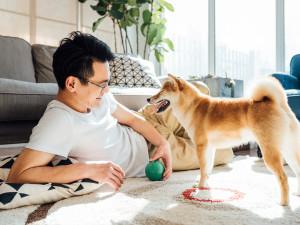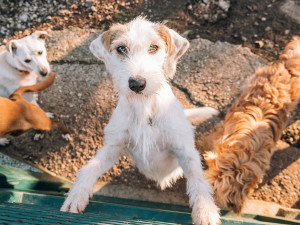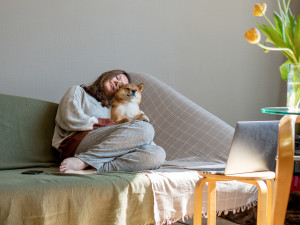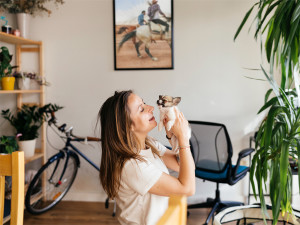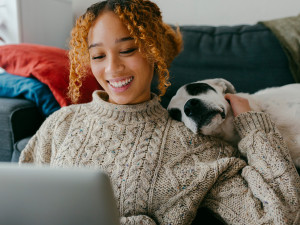How to Prepare for an Adoption Home Visit
7 tips for acing your inspection and bringing your new pup home.
So you’ve found a pet to bring into your family and filled out the adoption application. Many people don’t realize that when adopting from a rescue or shelter, there is often another step before you bring your pup home: The dog adoption home visit, where a representative from the rescue or shelter visits your house or apartment. Learn all about how to prepare for this step in the adoption process and what to expect from a home visit.
What is a home visit for adopting a dog?
You may be wondering why this step is necessary after you’ve already filled out an application. Shelters and rescues want to find the right home for each animal and ensure you will be a good pet parent. A home visit is their opportunity to make sure your home is suitable for a pet and remind you of the commitment and responsibility you’re accepting. In most cases, a home visit for dog adoption is just confirmation that your new pet will be safe, loved, and cared for as a member of your family.
Why do shelters do home visits?
Rescues and shelters often schedule a home visit to help them determine if your living environment and lifestyle are ideal fitsopens in new tab for the particular dog you want to adopt. It’s important that new pet parents have the time, resources, and knowledge to provide for their pet’s needs, and a home visit allows the shelter to make sure that the dog will have the loving home they deserve.
Why is preparing for an adoption home visit important?
Your adoption home visit is your opportunity to demonstrate that you can properly care for a rescue pet. Think of the apartment pet interview like a job interview — if you don’t prepare ahead of time, you likely won’t put your best foot forward.
Preparing for an Adoption Home Visit
Everyone in your household, whether other family members or roommates, should be involved in preparing for a home visit and new pet. You should talk to children about how to help take care of the dog and how to behave kindly toward animals.
To make a good impression on the adoption agency representative, you should also come prepared with your own questions to ask to show how invested you are in the process and how much thought you’ve given to taking care of a pet.
What should I do to prepare my home?
You want to show the shelter representative that you understand the responsibility of caring for a pet and will provide your new family member with everything they need to be happy and healthy. Take time to learn how to prepare for a dog and purchase all the required suppliesopens in new tab, like a crate, water and food bowls, a collar and leash, and plenty of fun toys.
What questions will a shelter ask me during adoption?
When asked, “Why do you want to adopt a dog?” answer truthfully and openly. A home visit is often more of a conversation than a formal interview, and while your answers may not determine the shelter’s final decision, the shelter representative will still ask you multiple questions to gauge your ability to care for a dog. Be prepared for the following dog adoption interview questions and answers:
Have you had experience with this particular type of animal before?
Does everyone in your household agree to get a new pet?
Do you have children? Are they comfortable and responsible with pets?
Do you currently have any pets? Are they compatible with other animals?
Do you rent or are you a homeowner?
Do you have a yard? Is it fenced in? If not, how do you plan to provide exercise, and how often?
Where will your pet be kept during the daytime? And at night?
How do you plan to care for your pet if you need to leave town?
No matter how much you prepare, you may receive some questions during the home visit that you aren’t sure how to answer. Give an honest response, and if you don’t know the answer, admit it. The shelter representative won’t expect you to know everything, and it’s better to admit your lack of knowledge than to make up an answer.
What can I do after the home visit to further support the adoption process?
An adoption home visit is also a chance for you to ask questions of the shelter representative about your potential new pet’s history and temperament. Below are some common questions to ask when getting a dog that can help you prepare for your newest family member:
What is the dog’s history?
Are there any health issues or concerns that I should be aware of?
Do you know what breed(s) the dog is?
What have you noticed about the dog’s personality?
Is the dog house-trained? Do they already know any basic commands?
Does the dog get along with children? With dogs? Other animals?
Knowing the questions to ask before adopting a dog shows that you are engaged in the adoption process and lets the shelter know that you care about providing a proper home for the dog as much as they do.
What are some common mistakes to avoid during an adoption home visit?
Like any other kind of interview, one of the worst things you can do during an adoption home visit is to give the shelter representative the answers you think they want to hear. Be honest and open with your answers — and with your home. That means giving the representative a full tour of the house, including where your pet will eat and sleep. You should also already have supplies for your dog before the home visit to show your preparedness and commitment.
What to Expect During a Home Visit
Your adoption home visit is a chance to show that you can and will provide your new pet with a safe and loving home. We asked Melissa Giordano, Adoption Coordinator of the Sato Projectopens in new tab, to fill us in on what to expect during this step of the adoption process, so you can better prepare to make the best possible impression.
1. It’s all about state of mind
Giordano emphasizes that shelters and rescues are looking for people who want to do best by their animals.
“We’re not looking for you to have a spotless home with perfect everything because that doesn’t exist,” Giordano says. “We just want to make sure that the dog is going to be safe and that the people are open to suggestions and are going to be thinking through things that could potentially cause a problem.”
So the first thing you can do is take a deep breath and frame the visit in your mind as a chance to have a better and safer environment for a pet.
2. Think like a nervous dog
Giordano emphasized that a major part of her organization’s work is making sure there are no easy ways for a pet to escape their adopter’s home because animals may try and make a break for it if they’re in a new space and spooked. That means making sure that all windows and doors close securely and that you’re not relying on a screen for preventing escape; that any air conditioning units are properly anchored and the soft closures around them held firmly in place; that fences and gates (if present) are fully secure; and that there are no easily accessible tables or chairs for them to get high enough to jump over.
3. Tidy up
Your space doesn’t need to be spotless, but you need to do a decent clean-up. You want the shelter to know that you’re capable of keeping your home clean and that there’s not anything dangerous for the dog to easily get into. That means securing any garbage containers so they’re not easy to knock over and rifle through; making sure any plants you have around are pet-safe; and, if you have cat litter, making sure the dog can’t get into it. Giordano points out that things you might not even think of could be a problem: “Kids’ toys — sometimes you don’t even think about it, but puppies will chew those apart and could potentially get injured or swallow something that could get stuck.”
4. But don’t be too precious with your belongings
Animals, unfortunately, can be destructive — even if they don’t mean to be. A newly introduced dog may make messes regardless of how house-trained they are as they struggle to get used to a new place. And they may chew or scratch if they’re particularly nervous. So go into the adoption process with the knowledge that there might be some damage around your home, and if you have any rugs, furniture, or extremely precious belongings that you can’t stand to see possibly hurt, put them away until the animal is totally settled and you know how they’ll behave.
5. Introductions, please
The agency will also want to meet whoever currently lives in your house — people and animals. Not every animal is suited to every living situation, so this helps them ensure that the pet is going into an environment where they will be comfortable. They’ll probably want an introduction to your family members, roommates, and any other animals onsite.
6. Be prepared for in-person or over video
In large part because of the pandemic, you may be asked to do a video home visit rather than one in person. This entails dialing into a video chat where a staff member can talk to you as you walk around the house and reveal anything they need a closer look at. Or they might just want you to video a home tour on your own and send it in, which can be easier to coordinate with everyone’s schedules.
7. Be open to change
Above all else, remember that this isn’t an adversarial visit. The shelter wants you and the animal to be the best possible match so that everyone can be happy and fulfilled with one another. Any suggestions they give are so that an animal you adopt will be safer and happier — so go into the process with an open mind and a willingness to adapt, and you’ll be fine.
“The people that are coming to do the home visits are not going to judge them,” Giordano says. “We are not looking for a perfect house. We are just getting a sense for the person or the family to make sure that it’s a match for our dog and that they’re able to give our dog the best, safest, and most loving home.”
What are the reasons for denying pet adoption?
Not every pet adoption application is accepted, and shelters have a number of reasons for denying an adopter. For example, if you work long hours, the shelter may be worried that the dog will spend too much time alone and won’t get the love and care they need.
Some other reasons for denying pet adoption include:
Your home doesn’t have a fenced yard or is too small for the dog
You already own several pets
You are too young (in college or younger) and may not have time to commit to a pet
You are too old and may not be able to properly care for a pet
You have young children in the home
Your current pets are not up-to-date on vaccinations and care
None of your current pets are spayed or neutered
Remember that every pet and every situation is different. The shelter just wants to find the best possible home for each dog in their care, and reasons for denying an adoption are in the pet’s best interests.
FAQs (People Also Ask)
Why is preparing for an adoption home visit important?
Preparing for your home visit shows that you are ready for the commitment of caring for a pet.
What should I do to prepare my home?
Prepare your home by purchasing the supplies you need to make your home safe and comfortable for your dog. Get rid of anything that could be dangerous to a pet.
How can I make a good impression on the adoption agency representative?
Be enthusiastic about the process, answer questions honestly and openly, and ask your own questions.
Should I involve my family members in the preparation process?
Family members should be involved because everyone in the household should be on the same page when bringing a pet into the home and should know what to expect.
What are some common mistakes to avoid during an adoption home visit?
Avoid giving answers you think the representative wants to hear. Instead, give accurate and honest answers.
How can I handle any unexpected questions or situations during the visit?
If you don’t have an answer to a question or are unsure, admit it. The representative will appreciate your honesty.
What can I do after the home visit to further support the adoption process?
After your home visit, continue to prepare your home for a new dog by purchasing supplies and asking the shelter questions about your new pet.
What are the reasons for denying pet adoption?
There are multiple reasons for denying pet adoption, including a lack of space, too many current pets, young children, and pets that are not spayed or neutered.
References:
How to Adopt a Dogopens in new tab
Muttville – How to Adopt a Dogopens in new tab
Korean K9 Rescue – Adoption Processopens in new tab
Rescue Dogs Rock NYC – Application Processopens in new tab
Sample Interview Question for Screeningopens in new tab


